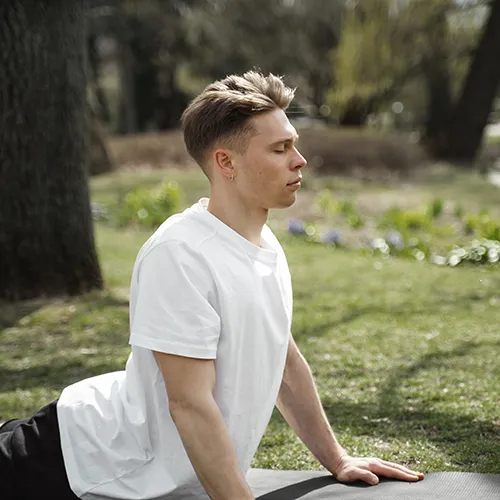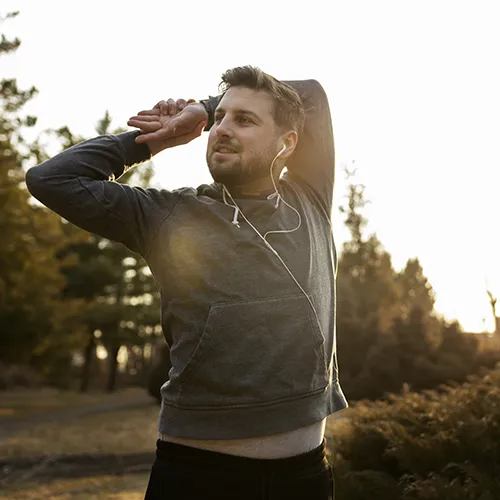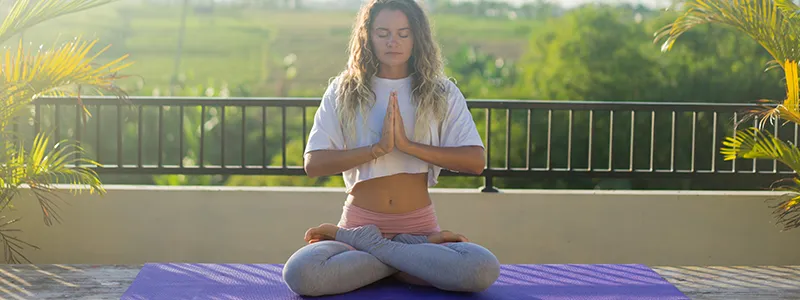Today, you will discover a series of breathing exercises that will help you calm your mind and strengthen your body. These breathing techniques are effective in improving your general well-being and achieving a more serene and healthy life. You will learn exercises to consciously control your breathing, you will understand the importance of maintaining adequate breathing and you will discover specific exercises to strengthen your lung capacity and relieve anxiety.

Key points:
- Breathing exercises can help you calm your mind and strengthen your body.
- Practicing conscious breathing techniques is important to improve your emotional well-being.
- There are specific exercises to strengthen your lung capacity and relieve anxiety.
- Maintaining proper breathing is essential for your overall health.
- Experiment and discover which of these exercises best suit your individual needs.
Breathing Techniques that Improve Mental Calmness
In this section, we will explore different breathing techniques that promote mental calmness and help reduce anxiety. These techniques are essential for establishing a deep connection with your body and mind, and will allow you to experience a feeling of peace and balance in your daily life. Below, you will learn some of the most effective techniques:

Deep Breathing Exercises
Deep breathing is one of the simplest and most effective techniques to calm the mind and relax the body. It consists of inhaling slowly through the nose, expanding the abdomen by filling the lungs with air, and then exhaling gently through the mouth. This exercise helps oxygenate the body, reduce stress and improve concentration.
Diaphragmatic Breathing
Diaphragmatic breathing, also known as abdominal breathing, is a technique that helps you control the amount of air you inhale and exhale, thus promoting relaxation and mental calmness. It consists of taking deep breaths, using the diaphragm (a muscle located below the lungs) to expand the abdomen as you inhale, and contract it as you exhale.
Techniques to Control Breathing in Stress Situations
When you find yourself in stressful or anxious situations, it is important to be able to maintain control of your breathing. To achieve this, you can practice techniques like square breathing, in which you will inhale, hold the air in your lungs, exhale, and keep your lungs empty for the same period of time. Another useful exercise is alternate breathing, where you will inhale through one nostril and exhale through the other, alternating between them.
These breathing techniques will give you powerful tools to face situations of stress and anxiety, allowing you to find a state of calm and well-being anytime, anywhere. Practice them regularly and experience the benefits of conscious and controlled breathing.
| Breathing Techniques | Benefits |
| Deep Breathing Exercises | Stress reduction and improved concentration |
| Diaphragmatic Breathing | Deep relaxation and body-mind connection |
| Techniques to Control Breathing in Stressful Situations | Emotional stability and responsiveness |
Exercises to Strengthen the Body and Improve Lung Capacity

In this section, we will present you with specific exercises that will help you strengthen your body and improve your lung capacity through proper breathing. These exercises combine breathing techniques with physical movements that will allow you to increase your resistance and optimize your lung health.
One of the most effective exercises to strengthen the body and improve lung capacity is resistance walking. It consists of walking at an accelerated pace while focusing your attention on your breathing. Inhale deeply through your nose for four steps and then exhale slowly through your mouth for another four steps. Repeat this breathing pattern while walking for at least 10 minutes a day. This exercise not only strengthens your lungs, but also improves cardiovascular endurance and promotes calorie burning.
Another beneficial exercise is yoga pranayama, a breathing technique used in yoga practice. Pranayama involves bringing attention to the breath and controlling it consciously. An effective technique is “belly breathing,” also known as diaphragmatic breathing. To perform this exercise, sit in a comfortable position with your back straight and place one hand on your abdomen. Inhale deeply through your nose, feeling your abdomen expand. Then, exhale slowly through your mouth, gently contracting your abdominal muscles. Continue this breathing pattern for several minutes, focusing on the conscious movement of the diaphragm. This exercise strengthens the respiratory muscles and increases lung capacity.
In addition to these techniques, you can also incorporate cardiovascular exercises such as running, swimming or cycling to improve your lung capacity and strengthen your body in general. These exercises will increase your heart rate and require greater breathing effort, which will help improve lung function in the long term.
Remember that proper breathing is essential to strengthen your body and improve your lung capacity. Practice these exercises regularly and experience the benefits of conscious breathing and a strengthened body.
Importance of Conscious Breathing for Health

Conscious breathing is a fundamental practice to maintain good health and well-being. Through this technique, you can experience a series of physical, mental and emotional benefits. By practicing mindful breathing exercises, such as deep breathing and diaphragmatic breathing, you can reduce stress, improve concentration, promote relaxation, and increase energy.
Conscious breathing involves paying attention and being aware of each inhalation and exhalation, tuning into the rhythm and flow of the breath. This allows us to connect with our body and mind, and helps us be present in the moment.
By incorporating these conscious breathing exercises into your daily routine, you can enjoy the following benefits:
Stress reduction:
- Conscious breathing helps activate the body’s relaxation response, reducing stress and anxiety levels.
- It allows you to calm down and find peace of mind in high-pressure situations.
Improved concentration:
- Conscious breathing increases mental clarity and improves the ability to concentrate.
- It helps you focus on the present moment and let go of distractions and worries.
Relaxation promotion:
- Conscious breathing induces a state of deep relaxation, which helps reduce muscle tension and calm the mind.
- It frees you from accumulated stress and gives you a feeling of calm and well-being.
Increased energy:
- Conscious breathing oxygenates the body more efficiently, providing a boost of energy and vitality.
- It helps you feel more alert, rejuvenated and better able to face daily challenges.
Incorporating conscious breathing into your daily life can make a big difference in your overall health and well-being. Take a few minutes a day to practice these exercises and experience the transformative benefits they can provide.
Conclusion
In this section, we will conclude by summarizing the key benefits and recommendations of the breathing exercises presented. We will remember the importance of regularly practicing these techniques to calm the mind and strengthen the body. Additionally, we will encourage you to experiment and discover which of these exercises best fit your individual needs.
Conscious breathing is a powerful tool to improve our physical and emotional well-being. By practicing it regularly, we can reduce stress, increase our concentration, relieve anxiety and improve our lung capacity.
We invite you to start practicing these breathing exercises right now. Dedicate a few minutes a day to perform these techniques and experience the benefits on your well-being. Find the right time and place for you, whether it’s during a deep breathing break at work, when you wake up in the morning, or before going to bed at night.
Remember that each person is unique, so it is important to experiment with different techniques and discover which ones best suit your needs and preferences. Don’t be discouraged if you find some exercises more difficult at first; With constant practice, you will improve and achieve the desired benefits.
Start practicing breathing exercises today and feel the difference in your physical, mental and emotional well-being!
FAQ
What is the importance of proper breathing?
Proper breathing is essential for our physical and mental well-being. Conscious, controlled breathing helps us oxygenate our body more efficiently, which improves lung function, strengthens our immune system, and helps us relax and reduce stress.
What are the benefits of conscious breathing?
Conscious breathing has numerous benefits for our health. By practicing it regularly, we can reduce stress, improve concentration and focus, promote relaxation, increase energy levels and improve our quality of sleep. Additionally, it can help us control our emotions and manage anxiety more effectively.
What is diaphragmatic breathing?
Diaphragmatic breathing is a deep breathing technique that involves consciously inhaling and exhaling using the diaphragm instead of breathing only with the chest. By breathing deeply through our diaphragm, we can take in more oxygen and expel more carbon dioxide, which helps relax the body and calm the mind.
How can I improve my lung capacity through breathing?
There are different exercises that you can do to improve your lung capacity through breathing. Some of them include deep breathing, intercostal breathing exercises, and pursed lip breathing technique. These exercises will strengthen your respiratory muscles and increase your ability to take in and expel more air.
What breathing exercises can I do to reduce anxiety?
To reduce anxiety, you can practice deep breathing, abdominal breathing, and square breathing technique. These techniques will help you slow your heart rate, relax your muscles, and calm your mind. Remember to do these exercises regularly and in a calm environment to obtain optimal results.
Follow all our blog articles and
Follow us on social networks! Facebook Instagram
Disclaimer
This article is for informational purposes only and should not be considered medical advice. It is not intended to diagnose, treat, cure, or prevent any disease. The information provided does not replace a consultation with a qualified physician or other healthcare professional. If you have symptoms, pre-existing medical conditions, or concerns about your health, consult a doctor before making any decisions based on this content. In case of a medical emergency, seek immediate care at a healthcare facility or call emergency services.
